2016 Health Seminar Breeding Recommendations
The Griffon Bruxellois Club of Victoria 2016 Health Seminar.
Two dogs + Two Months+ Responsible Breeder+ Responsible Griffon Owner = a healthy Griffon Puppy growing into healthy Adult Griffon dog.
Speakers: Mrs Vanessa van der Helm & Dr Iain Mitchell BVSc(Hons) MANZCVSc
TWO DOGS + TWO MONTHS = BREEDER ?
It might seem as if that’s all it takes, but there is much more to doing it right, producing puppies that will shine – whether they are destined for the show ring or a pet home. Breeding is a combination of so many separate aspects; it’s similar to building a house from the foundation to the roof. Breeding is an art form, an engineering project – labour and time intensive and an emotional and financial commitment. It is not something to enter into lightly or without adequate preparation.
Prospective breeders must become students of the breed, absorbing everything they can from the written record, the master breeders and the dogs themselves.
Where should the novice start?
Our Club, The Griffon Bruxellois Club of Victoria wanted to encourage responsible and ethical breeding practices so a Health sub-committee was formed some 4 years ago.
The Health sub-committee decided that a list of recommended Parental Health Tests should be encouraged and that we should produce a document (The Griffon Bruxellois Club Health Document) for breeders to document the test results of their breeding stock to pass on to their prospective puppy buyers. This document would also contain information such as their own contact details, list their pup’s Pedigree Registration and microchip numbers, information about the pup’s diet, health findings, vaccines and parasite treatments, and also list the health testing results of their pup’s parents.
What Parental Health Testing does our Club recommend?
We recommend that all breeders carry out,
· Patella (kneecap) testing for medial patella luxation.
· HD (Hip Dysplasia) testing.
· Veterinary Ophthalmologist examination to provide an Australasian Canine Eye Scheme (ACES) certificate.
These tests should be carried out for all their breeding stock and that they provide these results in The Griffon Bruxellois Club of Victoria Health Document that is given to the pup’s new owner.
We also recognise that the disease Syringomyelia/Chiara-like Malformation (SM/CM) is common in our breed, although rarely to a degree that affected dogs show clinical problems. Unfortunately these two interrelated neurological diseases can only be tested by means of an expensive MRI examination, which costs usually in excess of $1000 and can only be done at some Specialist facilities in Australia. Because the incidence of clinical disease is low and the fact that testing is very expensive, ANKC/Dogs Victoria does not insist that breeders must test for SM/CM. However, our Club encourages breeders who do SM/CM testing to also provide the results of any parent’s MRI scans in the Health Documents.
Our hobby is again under increasing scrutiny from the wider community and outside forces we must be diligent and cannot afford to be complacent.
So, what are a potential Griffon pet owner’s responsibilities for their Griffon?
Buy from a Dogs Victoria Member and use the Griffon Bruxellois Club of Victoria Health Documents.
Unfortunately just because a breeder is a member of Dogs Victoria is no guarantee that their primary motivation isn’t the income derived from breeding and selling pups without much regard for their health. Using the Club’s Health Documents will help you decide if your potential Griffon’s breeder bona fides are genuine. These documents are found on our Club website and are available for all breeders to use, whether they are a Club member or not.
-You will know to ask if they are a Dogs Victoria member and a Griffon Bruxellois Club of Victoria member.
-Do they provide a Dogs Victoria Pedigree/Registration Certificate, a current vaccination certificate and proof of microchipping ?
-Do they provide documentation of the pup’s diet, parasite prevention and any health concerns?
The opening three pages of our Health Document cover these questions.
Have any of the health testing recommended by our Club been performed on your potential pup’s parents and just as importantly, are the breeders providing any evidence of this testing?
If the answers are all affirmative then you have done all that can reasonably be expected to adopt a healthy puppy.
As already mentioned, the three health tests that we recommend for all breeding Griffons that are reasonable, affordable and can be easily be recorded in the Griffon Bruxellois Club of Victoria Health Documents are,
1. Patella Grading.
2. Australian Canine Eye Scheme (ACES) examination and certificate.
3. Hip Dysplasia Score.
Some breeders do the testing but the better ones actually use the test results to choose the best available combination of parents to minimize the chance of patella, eye and hip disease in their pups.
The fourth and fifth pages of our Club’s Health Document cover these questions,
The results of the patella exam will be recorded on the Griffon Club of Victoria Health Document; sometimes the vet may have issued their own certificate, of which the breeder should provide a copy.
What do the ACES and Hip Dysplasia Certificates that your breeder ideally should provide you look like? Also included is what a HD X-ray looks like.
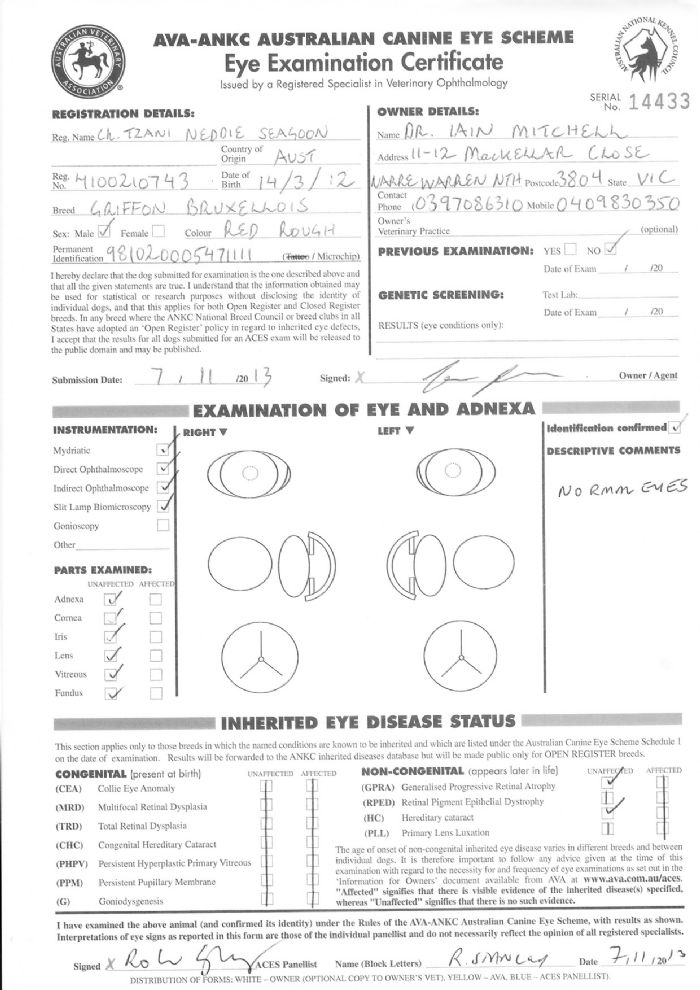
_Vet_Clinic_-_Virginia.jpg)
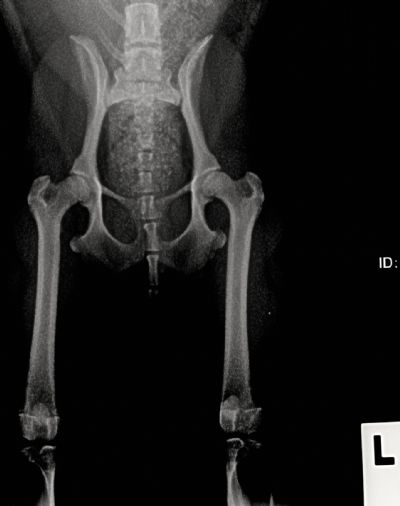
Just because one parent’s HD (Hip Dysplasia) score may be above the breed average doesn’t mean that he or she isn’t suitable for breeding, it just means that the breeder should try and select a sire with at least a score as far below the average as the dam’s score is above or vice versa.
Since the date on the HD report above, we have seen the breed average creep upwards to 27.4. This is a typical average score for many toy breeds.
Our Club has a HD Policy that serves to help breeders make decisions on how to use HD scores to plan what potential breeding Griffon’s should be used to lower the incidence and severity of this disease in our breed. It discusses what our average Griffon HD score means.
POLICY FOR HIP DYSPLASIA TESTING AND SUITABILITY FOR BREEDING
The Club Committee recommends that all breeding animals be radiographed for Hip Dysplasia (HD) and the X-ray be submitted to the ANKC Hip Dysplasia Scheme or a private Veterinary Radiologist Specialist, for scoring.
Currently the requirement is for an extended ventro-dorsal (VD) pelvic view radiograph done while the dog or bitch is under a general anaesthetic. The dog or bitch must be 12 months of age or older.
Hip Dysplasia has a high degree of heritability and the advice from the Australian ANKC panel of HD readers is to use dogs and bitches for breeding that have normal hips or mild departures from normal. If none of these dogs or bitches are available then dogs or bitches whose highest scoring hip is less than half the breed average score should be used. Having individuals with normal hips or mild departures from normal would be rare in Australia where the breed average score is currently 27.4. This breed average score is indicative of moderate to marked hip dysplasia where arthritis is already prominent OR severe hip dysplasia before arthritic change is evident. It is apparent from this average that the health of our Griffon’s hips is unsatisfactory and why our Club is recommending testing of all breeding stock and using these scores to breed responsibly without adversely diminishing our gene pool. So, if a dog with normal (score equal to 0) or near normal hips (score between 1 and 4) is unavailable, then dogs or bitches whose highest scoring hip is less than half the breed average score should be used.
If dogs are used for breeding with scores well below the breed average then it is likely puppies they produce will be well below the breed average and the hip status of the breed will improve. If we use dogs with a breed average result or those with a worse than breed average result then we would not expect to see any improvement.
Accordingly, the Club recommends that individuals, whose highest scoring hip is no more than a score of 13, should be used for breeding. At the very least, if a breeder is using a dog or bitch with an average score or a score above average, then the other dog or bitch should have a score below the average by at least the same margin as the other is above.
For example, a potential dam may have a hip score of 30 (score of 15 per hip). We would recommend that she be bred with a dog with a score of at least 24 but ideally even lower. In this way we should see an improvement in the health of our Griffon’s hips without restricting the potential gene pool too much and then seeing the incidence of other genetic diseases escalate.
For more information regarding Hip Dysplasia, how radiographs are done and explanation of how the score is calculated, go to the Club’s website
http://www.griffonclubvic.com/ask-dr-iainhip-dysplasia-testing.asp
Remember this?
The three health tests that we recommend for all breeding Griffons that are reasonable, affordable and can be easily be recorded in the Griffon Club of Victoria Health Documents are,
1. Australian Canine Eye Scheme (ACES) examination and certificate,
2. Patella Grading.
3. Hip Dysplasia Score.
There is a fourth Health Test that more breeders are doing nowadays that our Club, like Dogs Victoria, cannot insist that breeders should carry out and it is discussed in our Health Document……….
Syringomyelia (SM) and Chiari-like Malformation (CM)
Syringomyelia refers to the formation of fluid filled cavities inside the spinal cord just after its exit from the skull through an opening called the foramen magnum. These cavities can occur with another abnormality called Chiari-like Malformation (CM) where because of a disparity between the size of the brain and the hind portion of the skull the cerebellum and hindbrain will be pushed towards the back of the skull into the foramen magnum. It is thought by many specialists that the skull shape of Griffons and similar breeds such as the Cavalier King Charles Spaniel makes them susceptible to this combination of diseases. Some Griffons may have evidence of syringomyelia and cerebellar and hindbrain compression, yet show no neurological symptoms. However, those with more severe abnormalities can be expected to develop symptoms such as, scratching (at usually their shoulders for no other apparent reason), neck pain, episodes of pain and unsteady gait (ataxia).
The incidence of Griffons displaying neurological symptoms appears to be very low in Australia.
Unfortunately the only way currently to test for evidence of SM/CM is by an expensive MRI (Magnetic resonance imaging) procedure. At this stage Dogs Victoria and The Griffon Club of Victoria do not yet feel that mandatory MRI testing of all breeding stock is warranted. Our Club has contributed substantial funds for research into the disease by the University of Georgia, where MRI testing is characterising those affected with SM/CM and using this information to identify genetic markers of the disease that might lead to a simpler and more accessible DNA test for breeders. Some MRI research to date has been used to devise grading schemes for SM/CM and recommendations as to what grade individuals should be bred with other grade individuals but there is sometimes disparity between assessments made by different neurologists. We are hopeful that an accurate genetic based test may become available in the future.
Your breeder may have elected to have tested the sire and/or dam by MRI and if so should provide a copy of the specialist report to you that will indicate their recommendations for breeding.
Has the sire been tested for SM/CM by MRI? Yes/No. Has copy of report been provided? Yes/No.
Has the dam been tested for SM/CM by MRI? Yes/No. Has copy of report been provided? Yes/No.
There is some disagreement within our breed about the incidence of SM/CM. However, researchers generally state that it is present in the vicinity of 50% of Griffons that undergo an MRI. Most of these Griffons don’t have symptoms of clinical disease and this, combined with the cost of a MRI test which is usually in excess of $1000, means that Dogs Victoria is unlikely to make testing mandatory.
What does SM/CM look like on a MRI scan?
These are scans from an 8mth and 8 year old Cavalier King Charles Spanielwith SM2CM2 from a website listed further below. The white areas inside the spinal cord show the abnormal fluid filled cavities (syrinxes) that compress the spinal cord tissue while the arrow is showing where hindbrain tissue is being forced through the foramen magnum into space normally occupied by the spinal cord.
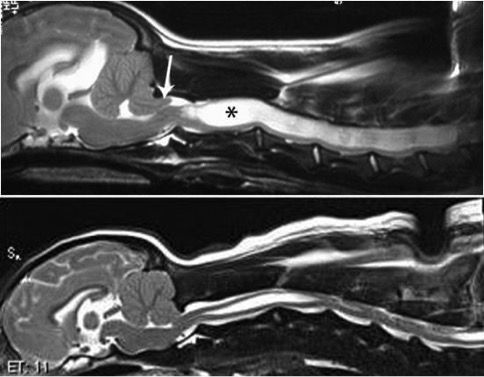
Do I think all breeders should MRI their breeding stock?
Introducing ‘Virginia’ (Aust Ch Griffonsburg Miss Virginia, owner Dr Iain Mitchell),
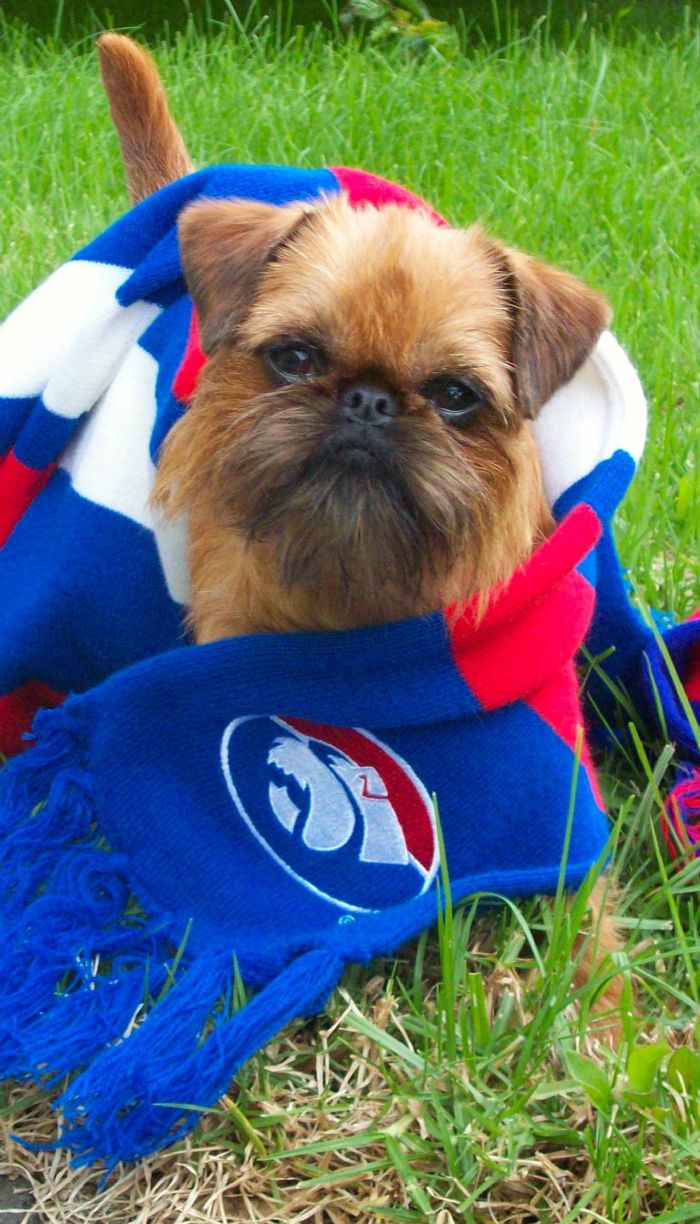
Virginia, a Western Bulldogs supporter and the most superb Griffon bitch I’ve ever seen in the show ring, was a complete outcross but at the time both of her parents had not been MRI screened. Subsequently they both have been and her sire is all clear while her mother has SM/CM but has not been graded. Virginia has had significant success in the Show Ring including Best of Breed at the 2013 Royal Melbourne Show and Bitch Challenge (Best Bitch) at the 2015 Royal Melbourne and Royal Queensland Shows and as of December 2015 has over 950 Championship points (100 points is required for a dog or bitch to qualify as a Australian Champion).
Virginia started having symptoms at about 2.3 years of age. She worsened over time until she was frequently scratching at her neck. I was always intending to MRI scan her before breeding and the scan confirmed that she had SM/CM. She will not be used for breeding.
Medication helped minimally and so she underwent surgery. Her procedure is called a Ventriculoperitoneal Shunt. It involves a Teflon coated tube being positioned inside the dilated CSF filled ventricles inside her brain, similar to what happens in hydrocephalus. Her ventricles were dilated because the CSF fluid was being blocked from exiting her brain via around the spinal cord. It was her cerebellum that was being forced into the opening at the back of the skull through which only the beginning of the spinal cord usually exits. This is the main feature of CM (Chiara-like Malformation) where there is not enough space in the hind portion of the skull for the brain. She also has the typical CSF filled cavities (syrinxes) in her cervical (neck) spinal cord of SM (Syringomyelia). Neurologists don’t fully understand why these cavities form but the compression they create on the surrounding neural tissue causes the neck pain symptoms that Virginia had.
The tube drains the CSF fluid from the fluid filled ventricle in the middle of her brain and exits via a hole drilled at the back of the skull and takes an interesting path around the top of her skull and ….
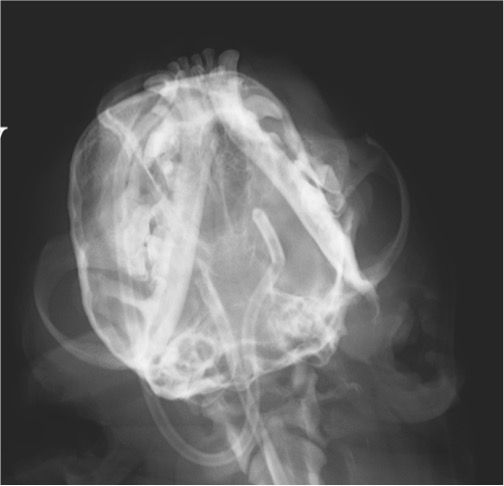
It then runs underneath her skin down the left side of her neck and chest until it enters her abdomen where the fluid is resorbed into her system. It relieves the pressure inside her brain and the spinal cord in her neck and should work for many years. Her symptoms are markedly reduced and she rarely requires additional medication.
She is back in the Show ring which she enjoys and some Judges certainly do feel the tubing on top of her head. She will not be used for breeding.
Do I want a potential puppy owner of a pup I’ve bred to go through what Lois, Virginia and I went through?
So, returning to the question….
Do I think all breeders should MRI their breeding stock?
Of course I do!! We should also use the guidelines developed by Veterinary Neurologists to select which Griffons to breed with. However, until the cost of MRI becomes less prohibitive or possibly the development of an economical and accurate genetic test, I support the Club’s policy that breeders who have MRI tested their breeding stock should share those results with the new owners of the puppies they have bred.
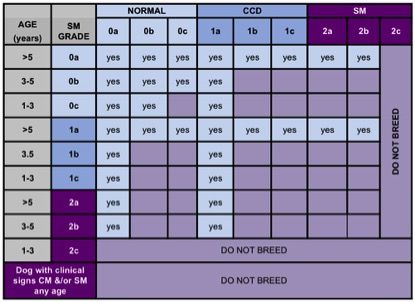
So as a potential Griffon owner you may want to buy a pup from a breeder who has MRI tested their breeding stock for SM/CM but these breeders are in the minority and you may have a long wait and possibly expect to pay more for your pup.
This website has links to Breeding Guidelines which explain this,
http://www.veterinary-neurologist.co.uk/Syringomyelia/
This site discusses the SM/CM Health Scheme that exists in the UK.
http://www.bva.co.uk/canine_health_schemes/ChiariMalformationSyringomyeliaSchemeCMSMScheme.aspx
What else is in our Health Document?
-We recommend investigating Health Insurance.
-We recommend secure fencing and housing inside the family home.
-We mention that there are no other diseases of significance in the Griffon for which there are genetic tests available.
-The breeder signs the form as an acknowledgement that they have actually provided the purchaser with all the certificates and information that they have ticked off in the Health Document.
-The breeder keeps the last two pages as a checklist and have the purchaser sign their copy to acknowledge that the certificates and information ticked off have been provided and any further explanations have been given to the purchasers satisfaction.
Remember this?
So ...you want to make the best choices for your new Griffon Puppy?
OR, in other words….
Two dogs + Two Months+ Responsible Breeder+ Responsible Griffon Owner = a healthy Griffon Puppy growing into healthy Adult Griffon dog.
and assuming you have done this…….
Buy from a Dogs Victoria Member and use the Griffon Club of Victoria Health Documents.
What next?
The Health Documents give brief advice about vaccinations, diet, parasite control, exercise and housing for your new pup just like your breeder and veterinarian can.
What are the reasons behind these recommendations regarding exercise, diet, parasite control and vaccinations?
See in Part 2
The Health Documents are available for all breeders, whether Club members or not on our website, http://webs.dogs.net.au/griffonclubvic/uploads/documents/2016_Health_Document.docx
Contact Details
President: Mrs Colleen De Haan [email protected]
Secretary -Mrs Robin Simpson [email protected]
Puppy enquiries - Beth Canavan [email protected]
0490085215
